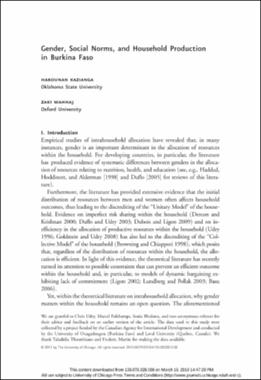| dc.contributor.author | Kazianga, Harounan | |
| dc.contributor.author | Wahhaj, Zaki | |
| dc.date.accessioned | 2019-08-22T17:50:51Z | |
| dc.date.available | 2019-08-22T17:50:51Z | |
| dc.date.issued | 2013 | |
| dc.identifier | oksd_kazianga_gendersocialno_2013 | |
| dc.identifier.citation | Kazianga, H., & Wahhaj, Z. (2013). Gender, social norms, and household production in Burkina Faso. Economic Development and Cultural Change, 61(3), 539-576. https://doi.org/10.1086/669258 | |
| dc.identifier.uri | https://hdl.handle.net/11244/321241 | |
| dc.description.abstract | Empirical studies of intra-household allocation has revealed that, in many instances, gender is an important determinant in the allocation of resources within the household. Yet, within the theoretical literature, why gender matters within the household remains an open question. In this paper, we propose a simple model of intra-household allocation based on a particular social institution for the organisation of agricultural production practised among certain ethnic groups in West Africa. We highlight how this institution, while resolving certain problems of commitment and informational asymmetry, can also lead to a gendered pattern in the allocation of productive resources and consumption within the household. Using a survey of agricultural households in Burkina Faso, we show, consistent with this theory, that plots owned by the head of the household are farmed more intensively, and achieves higher yields, than plots with similar characteristics owned by other household members. Male and female family members who do not head the household achieve similar yields. We argue that the higher yields achieved by the household head may be explained in terms of social norms that require him to spend the earnings from some plots under his control exclusively on household public goods, which in turn provides other family members the incentive to voluntarily contribute labour on his farms. Using expenditures data, and measures of rainfall to capture weather-related shocks to agricultural income, we show that the household head has, indeed, a higher marginal propensity to spend on household public goods than other household members. The fact that the head of the household is usually male accounts for the gendered pattern in labour allocation and yields across different farm plots. | |
| dc.format | application/pdf | |
| dc.language | en_US | |
| dc.publisher | University of Chicago Press | |
| dc.rights | This material has been previously published. In the Oklahoma State University Library's institutional repository this version is made available through the open access principles and the terms of agreement/consent between the author(s) and the publisher. The permission policy on the use, reproduction or distribution of the material falls under fair use for educational, scholarship, and research purposes. Contact Digital Resources and Discovery Services at lib-dls@okstate.edu or 405-744-9161 for further information. | |
| dc.title | Gender, social norms, and household production in Burkina Faso | |
| osu.filename | oksd_kazianga_gendersocialno_2013.pdf | |
| dc.description.peerreview | Peer reviewed | |
| dc.identifier.doi | 10.1086/669258 | |
| dc.description.department | Economics | |
| dc.type.genre | Article | |
| dc.type.material | Text | |
| dc.subject.keywords | intra-household allocation | |
| dc.subject.keywords | social norms | |
| dc.subject.keywords | gender | |
| dc.subject.keywords | household public goods | |
